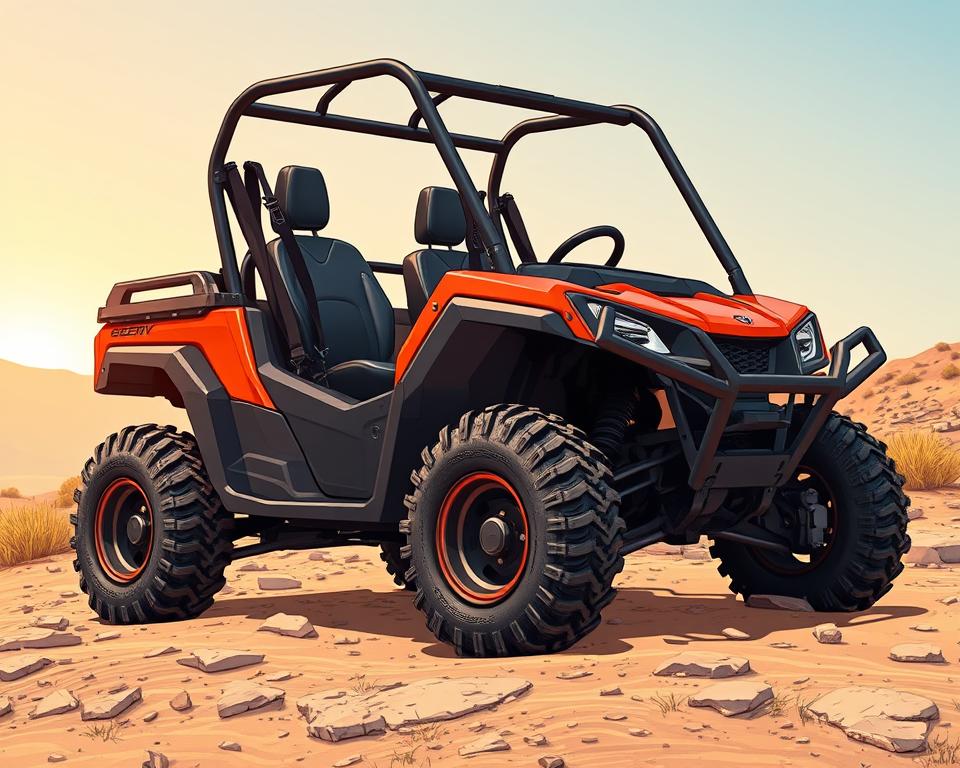How New Riders Can Avoid ATV/UTV Gear Selection Pitfalls
Did you realize that nearly 25% of new ATV and UTV owners face gear selection issues within their first year? Such data emphasizes how critical gear ratios are for novice riders. It’s not just about performance; it’s also about safety on the trails. We’ll explore common mistakes, maintenance practices, and expert side by side UTV accessories advice to improve your off-road adventures.
Critical Findings

- Understanding gear ratios is vital for optimal ATV/UTV performance.
- Common gearing oversights can lead to safety risks on the trails.
- Routine care averts transmission breakdowns.
- Smart gear choices transform your outdoor rides.
- Following upkeep advice extends your ATV’s life.
Understanding ATV and UTV Gear Ratios
Ratios determine how engine output translates to drive force. They dictate how engine power translates into speed and torque. This controls how quickly you get up to speed and tow trailers. By picking specific ratios, you tailor your ride for drag, trail, or work.
Picking the correct ratio optimizes power delivery. Excessively low gearing reduces hill-climbing pull. Conversely, too high a ratio hampers quick takeoffs on flats.
Adjusting reduction influences handling in mud, sand, and rock. Ratio mods shape how your rig behaves off-road. This ensures the machine operates efficiently, whether prioritizing speed or torque. Achieving the right balance in ATV gear ratios improves the driving experience and boosts efficiency.
Common Gearing Oversights for New ATV/UTV Owners
Choosing the right gear is key to optimal performance and safety when riding an ATV or UTV. Many new owners overlook critical aspects of gear selection. Knowing what happens when you misgear and how to fix it transforms your experience. And it sidesteps needless breakdowns.
Impact of Incorrect Gear Selection
Misgearing risks crashes and costly damage. Poor gear choice dampens speed, stresses brakes, and accelerates wear. Such errors endanger everyone, from driver to bystanders. Following key ATV maintenance tips can help avoid these issues.
Choosing the Right Gear for Terrain
Different terrains need different gearing for efficient performance. To conquer grades, use lower speeds and higher torque. To cover ground quickly, shift to higher ratios. Mucky surfaces require cautious gearing to maintain momentum. Knowing these environmental factors is critical for safe and enjoyable off-road adventures.
The Importance of Proper ATV Maintenance
Scheduled service avoids surprises on the trail. Adhering to care guides prevents sudden failures and enhances safety. A well-planned maintenance schedule focuses on the gear system’s health.
Regular Inspection and Maintenance
Using a checklist uncovers faults before they escalate. It’s important to check gears, brakes, tires, and belts regularly. Integrating inspections into your schedule boosts reliability. Here are some critical inspection points to remember:
- Inspect gearbox alignment and pitting.
- Ensure all fasteners are tight.
- Inspect brake lines and levels.
- Inspect tire pressure and tread depth.
- Inspect battery terminals and cables for buildup.
Fluid Changes and Gear Health
Fluid quality is critical for UTV drivetrain maintenance. Routine fluid swaps avoid sludge and varnish. Pure coolant and oil lower temperatures and prolong service intervals. Adopting this routine preserves drivetrain health and trail readiness.
| Fluid Type | Recommended Change Interval | Benefits of Regular Change |
|---|---|---|
| Engine Oil | 50–100 operating hours | Reduces engine wear, enhances performance |
| Differential Oil | 100–200 operating hours | Improves shifting, minimizes gear damage |
| Coolant | Once per year | Prevents overheating, maintains optimal temperature |
Sticking to this plan ensures uninterrupted trail fun. It turns rides into stress-free experiences.
Common ATV Gear Shifting Problems
New ATV riders often face challenges with gear shifting. Developing fluid shift skills elevates trail enjoyment. You avoid jerky starts and stops. Timing throttle and clutch releases prevents gears from crunching.
Learning to Shift Smoothly
Developing smooth shifting techniques requires a few practices. Start by getting to know your ATV engine’s rhythm. Careful engagement protects internals and stops wear. Matching revs while you let out the clutch is essential.
Rehearse gear changes in a safe area before heading out. Keep your throttle light when shifting.
Recognizing Signs of Gear Issues
Early detection of gear issues is essential. Watch for whines, clanks, or crunches in the gearbox. Hard shifts or missed gears indicate trouble. Fixing problems fast keeps you safer on the trail. Correcting misgears sustains reliability and your enjoyment.
Understanding UTV Transmission Issues
Transmission headaches are common; understanding them aids fixes. Frequent complaints include gears that pop out and strange whines. Here we examine usual faults and outline a step-by-step fix plan. It’s based on a practical UTV troubleshooting guide.
Diagnosing Common Problems
Recognizing the signs of transmission troubles is essential. Common issues include:
- Gears that pop out under load, risking accidents.
- Unusual sounds, such as grinding or whining, indicating mechanical damage.
- Drips or puddles under the UTV may foretell failures.
Regular gear diagnostics help spot these issues quickly. This allows for prompt action. Ignoring these signs can lead to expensive repairs and reduced performance.
Solutions for Troubleshooting UTV Transmissions
Solving drivetrain faults depends on a structured routine. Follow these steps for effective troubleshooting:
- Ensure gearbox fluid is at spec, then add if low.
- Inspect pan and seals for drips.
- Inspect the gearbox for wear or damage.
- Operate the UTV under different loads to observe shift quality.
- Check OEM guides for model-specific repair advice.
Leveraging a proven guide speeds up repairs. Understanding gear mechanics is key for any UTV owner. This knowledge boosts lifespan and performance.
ATV Clutch Adjustments and Their Benefits
Accurate clutch tuning unlocks seamless shifts. Incorrect adjustments can make shifting gears tough, frustrating for beginners. Routine calibration refines clutch response and engagement.
Fine-tuning clutch engagement matters. Correctly calibrated clutches enable flawless transitions. It refines acceleration and comfort across all conditions.
Skipping clutch care leads to early failures and poor shifts. Regular tuning keeps shifts sharp and the motor lively. Every operator should prioritize clutch checks for optimal use.
Mastering the Art of Gear Shifting
Becoming adept at shifts transforms your off-road sessions. You need mechanical insight and precise timing to nail each shift. Beginners should focus on the rhythm of shifting gears. A comfortable cadence leads to smoother transitions and improved performance.
Smooth shifts arise from varied-condition training. Understanding when to shift gears based on terrain type enhances control and safety. Dropping a gear before a climb preserves torque and control.
- Practice shifting at low speeds to build confidence.
- Observe how your vehicle responds to different shifts.
- Step up to steeper, rougher trails as you improve.
Developing a feel for your machine is essential in mastering gear control. Heed revs and shakes to know shift points. This helps determine the optimal moments to shift. That instinctive skill yields seamless shifts and more fun.
Best Practices for UTV Gear Selector Problems
Resolving gear lever faults requires regular inspection and testing. Routine linkage reviews catch wear promptly. Perfecting selector methods wards off glitches. Inspect link rods and fluid status as part of every service.
When facing gear selector issues, first check the selector mechanism for obstructions or damage. Clunks or rattles can signal a loose linkage. Simple adjustments and cleaning often solve issues without needing major repairs. Scheduled servicing prevents selector degradation.
Tracking shift quality across terrains isolates faults. These best practices not only extend the gear selector’s life but also make riding safer and more enjoyable.
Tips for Enhancing Gear Performance
Sustaining peak gear health involves systematic care. Scheduled upkeep enhances ATV efficiency. Monitor fluids, look for damage, and fine-tune as required. A simple inspection can prevent extensive damage and costly repairs.
Selecting proper reductions yields prompt acceleration and fluid movement. Assessing ground conditions guides your ratio picks. It influences your launch and maximum velocity. Partnering with trusted makers like American Off-Roads for UTV performance enhancements adds power and reliability.
Implementing gear performance tips in wheels, springs, and ballast optimization elevates function. Those mods lead to stable, confident rides across tough terrain. Your rides become more fun and less fatiguing. Implementing these strategies will allow riders to navigate with confidence while enjoying the thrill of the ride.
Conclusion
Getting your gears right is the key to speed and security. Matching gears to ground types transforms your adventure. Steering clear of rookie errors and picking wisely ensures safe, thrilling rides.
The importance of performance maintenance cannot be overstated. Regular checks and upkeep are key to avoiding problems and extending your vehicle’s life. Good upkeep maximizes output and secures your rides in all conditions.
Merging smart ratio choice and regular upkeep yields the best off-road enjoyment. Adopting these practices ensures many memorable rides and adventures in the future.
FAQ
Standard gear ratios on off-road rigs?
Ratio specs differ greatly by manufacturer and use case. Typical ratios lie within the 3-to-5 range. Smaller ratios deliver grunt for trails and climbs. Large ratios favor maximum velocity on smooth surfaces.
Signs of misgearing for different surfaces?
Misgearing risks unstable handling, rev overload, or sluggish starts. Each terrain type—mud, sand, rock, or snow—requires specific gear selection for optimal performance.
How to know when your machine needs service?
Look out for signs like difficulty shifting gears, unusual noises from the transmission, fluid leaks, or a decrease in performance. Periodic drive train reviews ward off costly repairs.
When to swap your drivetrain oils?
Rotate your oils at 1.5–2.5K miles or yearly, based on how and where you ride. Pure oils maintain smooth shifts and protect internals over time.
How to shift gears without jerking?
For smooth gear shifting, practice coordinating the throttle and clutch. Feather the clutch up while winding the throttle for a perfect match.
Steps to diagnose gearbox problems?
Start by checking for common problems like slipping gears or strange noises. Inspect the transmission fluid level and condition. Next, test-drive at varied speeds to see how it shifts.
What is the importance of clutch adjustments in an ATV?
Proper clutch adjustments are essential for smooth gear transitions. Incorrect clutch setup strains the gearbox and causes sticky shifts.
Adapt gearing for every surface?
Test multiple gearing options and look into quality mods by American Off-Roads. Routine upkeep—fluid swaps and gear checks—boosts efficiency.
What should I do if my UTV gear selector is malfunctioning?
Regular inspections and routine maintenance are key. When the shifter binds, use the OEM troubleshooting procedures to find the root cause.
Beginner pitfalls in gear selection?
Rookies tend to ignore ratio basics, delay upkeep, or misgear for mud, rock, or hills. These oversights can lead to inefficient operation and safety concerns.


